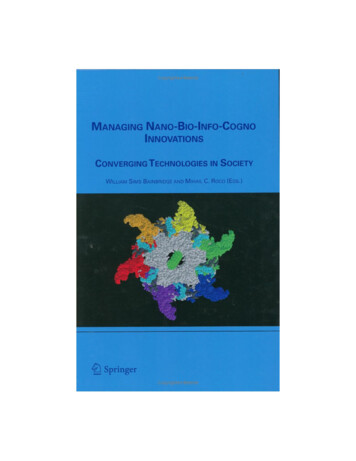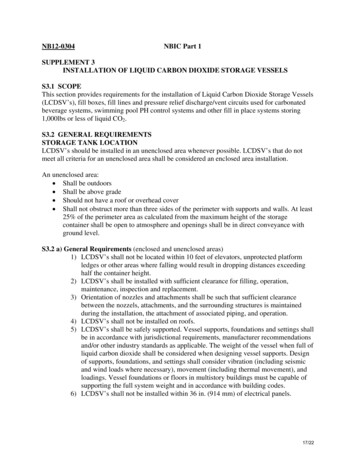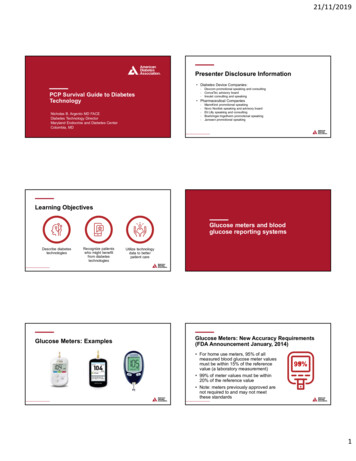
Transcription
CHNOLOGIES INSOCIETYedited byWilliam Sims Bainbridge*National Science FoundationandMihail C. RocoNational Science Foundation*National Science and Technology Council’sSubcommittee on Nanoscale Science, Engineering, and Technology2005*Any opinions, findings, and conclusions or recommendations expressed here are thoseof the authors and do not necessarily reflect the views of National Science Foundation orthe National Science and Technology Council.
A.C.I.P. Catalogue record for this book is available from the Library of Congress.ISBN-10 1-4020-4106-3 (HB)ISBN-13 978-1-4020-4106-8 (HB)ISBN-10 1-4020-4107-1 (e-book)ISBN-13 978-1-4020-4107-5 (e-book)Published by Springer,P.O. Box 17, 3300 AA Dordrecht, The Netherlands.www.springeronline.comPrinted on acid-free paperAll Rights Reserved 2006 to the complete printed work by Springer, except as noted. Individual authors ortheir assignees retain rights to their respective contributions; reproduced bypermission. After the authors and editors had completed their work, the Directoratefor Engineering of the U.S. National Science Foundation decided to acquire a numberof copies of the report for limited distribution among some of its science andengineering communities. Therefore, publication of this work was supported in partby a grant (0423742) from the National Science Foundation to The WorldTechnology Evaluation Center (WTEC), Inc. The U.S. Government retains anonexclusive and nontransferable license to all exclusive rights provided bycopyright. Any opinions, conclusions, or recommendations expressed in this materialare those of the authors and do not necessarily reflect the views of their respectiveemployers.Printed in the Netherlands.
iTABLE OF CONTENTS1. Progressive Convergence. By William Sims Bainbridgeand Mihail C. Roco12. The Emergence and Policy Implications of Converging NewTechnologies. By Mihail C. Roco93. Roadmapping Convergence. By Richard E. Albright234. NBIC Convergent Technologies and the Innovation Economy:Challenges and Opportunities for the 21st Century. By James Canton335. Measuring the Merger: Examining the Onset of ConvergingTechnologies. By Evan S. Michelson476. Collaboration on Converging Technologies: Education and Practice.By Michael E. Gorman and James Groves717. If We Build It, Will They Come? The Cultural Challenges ofCyberinfrastructure Development. By Thomas A. Finholtand Jeremy P. Birnholtz898. Converging Technologies in Developing Countries: PassionateVoices, Fruitful Actions. By Jim Hurd1039. Nanotechnology for Biology and Medicine. By James R. Baker11910. Biologically-Inspired Cellular Machine Architectures. By Gary H.Bernstein, Leon O. Chua, Arpad I. Csurgay, Patrick Fay, Yih-FangHuang, Wolfgang Porod, Angel Rodriguez-Vasquez, Botond Roska,Tamas Roska, Frank Werblin, and Akos Zarandy13311. Cognitive Enhancement and the Neuroethics of Memory Drugs.By Wrye Sententia15312. Neuropolicy (2005-2035): Converging Technologies EnablesNeurotechnology Creating New Ethical Dilemmas. By Zack Lynch17313. Information Technology and Cognitive Systems.By Robert St. Amant193
iiTable of Contents14. Cognitive Technologies. By William Sims Bainbridge20315. NBIC Convergence and Technology-Business Coevolution: Towardsa Services Science to Increase Productive Capacity. By Jim Spohrer,Douglas McDavid, Paul P. Maglio, James W. Cortada22716. An Ethic for Enhancing Human Performance Through IntegrativeTechnologies. By George Khushf25517. Science Confronts the Law. By Sonia E. Miller27918. Human Enhancement and the Emergent Technopolitics of the 21stCentury. By James J. Hughes28519. Co-Evolution of Social Science and Emerging Technologies.By Bruce E. Tonn309APPENDIX 1: Survey of NBIC Applications.By William Sims Bainbridge337APPENDIX 2: Information Technology for Convergence.By William Sims Bainbridge347APPENDIX 3: Commercializing and Managing the Converging newTechnologies. By Michael Radnor and Jeffrey D. Strauss369Index383
11. PROGRESSIVE CONVERGENCEWilliam Sims Bainbridge and Mihail C. Roco, National Science Foundation1Abstract: This introductory chapter briefly defines the “NBIC” unificationthat is rapidly taking place today among Nanotechnology, Biotechnology,Information technology, and Cognitive science. It then describes how theother chapters address the potential impacts of converging technologies,considers how innovation can be stimulated and steered, and provides a basisfor an understanding of the societal implications of NBIC.IntroductionAt this point in history, tremendous human progress becomes possiblethrough converging technologies stimulated by advances in four core fields:Nanotechnology, Biotechnology Information technology, and newtechnologies based in Cognitive science (NBIC). Many individual authorshad noticed the gathering convergence of technical disciplines, andsociobiologist E. O. Wilson wrote an especially influential 1998 book on theemerging harmony among the sciences. However, convergence becameespecially visible, and scholarship about its causes and consequences becamevery active, through a major 2001 conference, sponsored by the U.S.National Science Foundation and Department of Commerce, that resulted in asubstantial book (Roco and Bainbridge, 2003). The intellectual basis ofconvergence was strengthened by three further annual conferences held inLos Angeles in 2003, New York City in 2004, and near Kona, Hawaii, in2005. The Los Angeles meeting resulted in a second book (Roco andMontemagno, 2004), and this third volume is an outgrowth of the New Yorkconference. The question raised at the first conference – “if visionaryactivities related to NBIC would have impact?” – has been replaced in thefollowing meetings with “how and when?” – aiming at anticipatory measuresfor taking advantage better, sooner and in a responsible way for society.The effort springs from an ongoing attempt to understand the societalimplications of nanoscience and nanotechnology, which was energized by a2000 conference organized by the National Science Foundation at the requestof the National Science and Technology Council (NSTC), Subcommittee onNanoscale Science, Engineering, and Technology (NSET), and the resultantbook (Roco and Bainbridge, 2001). Subsequently, a number of workshopsand publications have achieved progress in this area (Roco, 2002, 2004,2005; Roco and Bainbridge, 2002, 2005; Bainbridge, 2003, 2004; Miller,1Any opinions, findings, and conclusions or recommendations expressed here arethose of the authors and do not necessarily reflect the views of NSF.
21. Progressive Convergence2003; Nordmann, 2004; Radnor and Strauss, 2004). NBIC convergence ismuch more than merely an adjunct of the nano revolution in science andengineering, but it draws great strength from the concurrent and synergisticbreakthroughs achieved in the four domains of NBIC in recent years.Nano-Bio-Info-Cogno UnificationTechnological convergence is progressive in two important senses of theterm. First, the NBIC fields are in fact progressively merging, step by step,and apparently at an accelerating rate. Second, the unification of the greatrealms of technology will promote human progress, if they are appliedcreatively to problems of great human need. Indeed, unless convergencetakes place, in both the technical and social realms, it is hard to see howhumanity can avoid conflicts, such as those that marred the 20th century,caused by limited resources for available technology and social differenceswithin each county and globally. Only by moving to a higher technologicallevel will it be possible for all of the peoples of the world to achieveprosperity together without depleting essential natural resources to the pointat which the future of civilization itself is in doubt.The great convergence that is taking place today should not be mistakenfor the mundane growth of interdisciplinary or multidisciplinary fields. Formany decades, small-scale convergence has taken place in areas such asastrophysics, biochemistry, and social psychology. However significant theselocal convergences have seemed for the scientists involved in them, they palein comparison with the global convergence that is posed to occur in thecoming decades. It will constitute a major phase change in the nature ofscience and technology, with the greatest possible implications for theeconomy, society, and culture.NBIC convergence requires, and is made possible by, the radically newcapabilities to understand and to manipulate matter that are associated withnanoscience and nanotechnology. The integration of technology will bebased on the unity of nature at the nanoscale, as well as an informationsystem that would cross disciplines and fields of relevance. Conventionallydefined as the size range from 1 to 100 nanometers – from 1/1,000,000 to1/10,000 of the thickness of an American dime – the nanoscale is wherecomplex molecules form, where the building blocks of living cells arestructured, and where the smallest components of computer memories andprocessors are engineered. Remarkably, many of the key structures of thevast human nervous system exist at the nanoscale, such as the vesicles thatstore neurotransmitters, the gap between neurons across which thoseneurotransmitters flow, and the pigment molecules in the eye that makevision possible. Recent advances in nanoscience and nanotechnology enable
Converging Technologies for Human Progress3a rapid convergence of other sciences and technologies for the first time inhuman history.Many of the most powerful developments in biotechnology andbiomedicine are taking place at the nanoscale. This is true not merely ingenetic engineering (with DNA molecules about 3 nanometers in width),imaging (with quantum dots of few nanometers), targeted drugs (withnanoparticles as carriers), and biocompatible prosthesis (with molecules “bydesign”) – but also in those many branches of biotechnology where improvedunderstanding of the processes that give life to cells would be advantageous.Thus, much biotechnology today – and increasingly more in the future – is avariant of nanotechnology. Beginning students of chemistry are oftenperplexed when they learn that organic chemistry does not necessarilydepend upon biology, because the term refers to a broad class of complexmolecules that need not have been produced by living organisms. Syntheticbiology and engineering of nanobiosystems are recently introduced terms.Because both nanotechnology and biotechnology often deal with complexmolecules, tools and concepts developed in one can be applied in the other,facilitating convergence.Modern information technology is based on microelectronics, which israpidly evolving into nanoelectronics. As a first step, computer chips aremanufactured by processes such as photolithography that deposit many thinlayers of substances on the chip, then etch away unneeded areas. The layerson the chips, as well as the layers on magnetic disks that store data, havebecome nanoscale thin, and this very thinness gives them unique electricproperties. The current advances on nanolayers with special insulation orconducting properties will evolve to three-dimensional nanostructures anddevices and may lead to replacing the information carrier from electroncharge to new carriers such as electron spin, photon, or quantum state.Recently, the width of the transistors on a chip has also moved into thenanoscale, with some being only 50 nanometers wide. Currently, researchersare exploring a number of avenues for achieving molecular computing – suchas building transistors out of carbon nanotubes – that could form the basis ofa new generation of computing, achieving much greater information densitiesand processing speeds with significantly reduced power requirements. At thesame time, progress in nanotechnology and biotechnology is dependent uponconstantly improved sensing instrumentation and information processingcapabilities. Furthermore, hierarchical system approaches with emergingbehavior originating from the nanoscale will require new simulationcapabilities, and large databases and computers will allow quantitativeevaluation of interdependent technological, economic, and social phenomena.Of the four NBIC fields, cognitive science is the least mature, but for thisvery reason, it holds very great promise. This is a multidisciplinaryconvergence of cognitive and perceptual psychology, linguistics, cultural
41. Progressive Convergenceanthropology, neuroscience, and artificial intelligence aspects of computerscience. The incomplete nature of this local convergence is suggested by thefact that to date sociology and political science have not participatedsignificantly in the development of cognitive science, even though manysociologists and political scientists study the formation and transmission ofknowledge, belief, and opinion. Although parallel work is being done ineconomics, much is only loosely connected to cognitive science. Clearly,neuroscience and artificial intelligence tie cognitive science to biology and toinformation science, but links to nanoscience are also visible on the horizon,both through the emerging understanding of the functions of neurons on thenanoscale and through new nano-enabled research methodologies forstudying the brain and human-tool/machine interaction.As cognitive science matures, it not only gains more and moreopportunities for convergence with other sciences but also becomes a solidbasis for a range of innovative new technologies advancing individual andgroup creativity. Human intellectual and social performance will be greatlyenhanced by nano-enabled, portable information systems and communicationdevices, by biotechnology treatments for disorders of the mind or memory,and by increased understanding of how the human brain and senses actuallyfunction.All branches of science and technology may be converging, but NBICconvergence is especially influential. These are
3. Roadmapping Convergence. By Richard E. Albright 23 4. NBIC Convergent Technologies and the Innovation Economy: Challenges and Opportunities for the 21st Century. By James Canton 33 5. Measuring the Merger: Examining the Onset of Converging Technologies. By Evan S. Michelson 47 6. Collaboration on Converging Technologies: Education and Practice.











